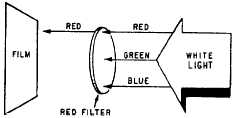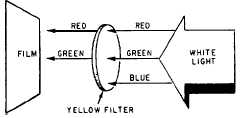CHAPTER 3
PHOTOGRAPHIC FILTERS
Filters are used in all the various steps of the
photographic process. Though often neglected in the
shooting stage, the use of filters can tremendously
enhance the final product in both black-and-white and
color photography.
PURPOSE OF PHOTOGRAPHIC
FILTERS
The purpose of photographic filters is to alter the
characteristics of light that reaches the light-sensitive
emulsion As light is transmitted through a filter, at least
one of the following alterations occurs:
1. The color of light is modified.
2. The amount of light is reduced.
3. The vibration direction of the light rays is
limited.
The two most important reasons for using
photographic filters are to create an effect with an
emulsion and to control the exposure of an emulsion.
Interlocked with the use of filters are characteristics of
light and characteristics of photographic emulsions. The
effectiveness of a filter depends upon the ability of an
emulsion to respond to the color of light transmitted by
the filter.
Colored filters modify the way colors are recorded.
Without the use of filters, black-and-white
panchromatic film records colors as gray tones. These
gray tones correspond roughly to the tonal range as seen
by the human eye. Colored filters selectively brighten
or darken these tones. In color photography, colored
filters are used to correct or distort color balance.
Filters of a specific color transmit most of the light
of that color and partially or completely absorb light of
all other colors. For example, a red filter transmits red
light and may partially or completely absorb blue and
green light, depending on the deepness or purity of its
color (fig. 3-1). Likewise, a yellow filter transmits red
and green light and partially or completely absorbs blue
light. Remember, a secondary color of light is produced
by combining two primary colors of light. Red and green
equal yellow; thus a yellow filter passes red and green
light.
Figure 3-1.–Red and yellow filters.
Filters are available in three forms: optical glass
disks bound with metal rims, lacquered gelatin film
squares, and glass squares. Glass disk filters are the most
practical for general use. They are available in different
sizes called series numbers, such as Series 4,5, and 6 or
in millimeter sizes, such as 52mm and 59mm. Glass disk
filters attach to a camera lens in two ways. Some have
threads and screw directly into the lens barrel, and the
others are held on the lens barrel by an adapter ring.
Gelatin filters and square filters made of glass are either
inserted into special filter holders that are part of the
camera, or they are held on the camera by a square filter
holder.
FILTER DESIGNATIONS
Filters are usually identified by numbers. This
system of designating filters is used to identify Kodak
Wratten filters. It uses designators, such as No. 6, No.
8, and No. 11. Some filters have a descriptive name
rather than a number; for example, polarizing, skylight,
and neutral density. Color compensating and color print
filters have yet another designation system.
3-1



